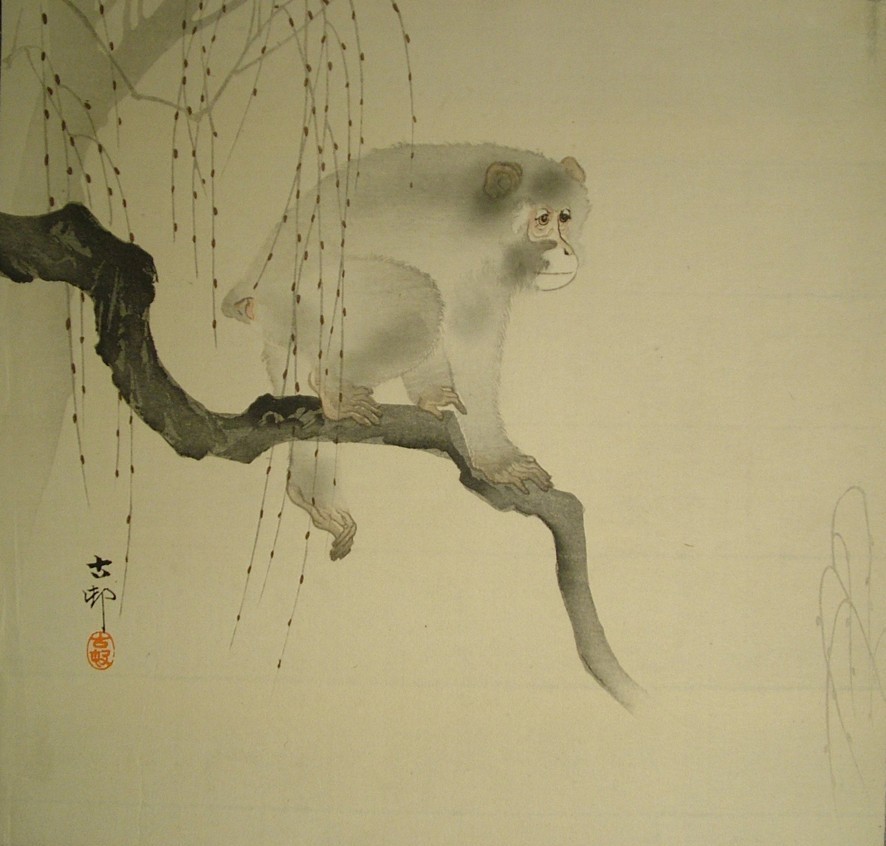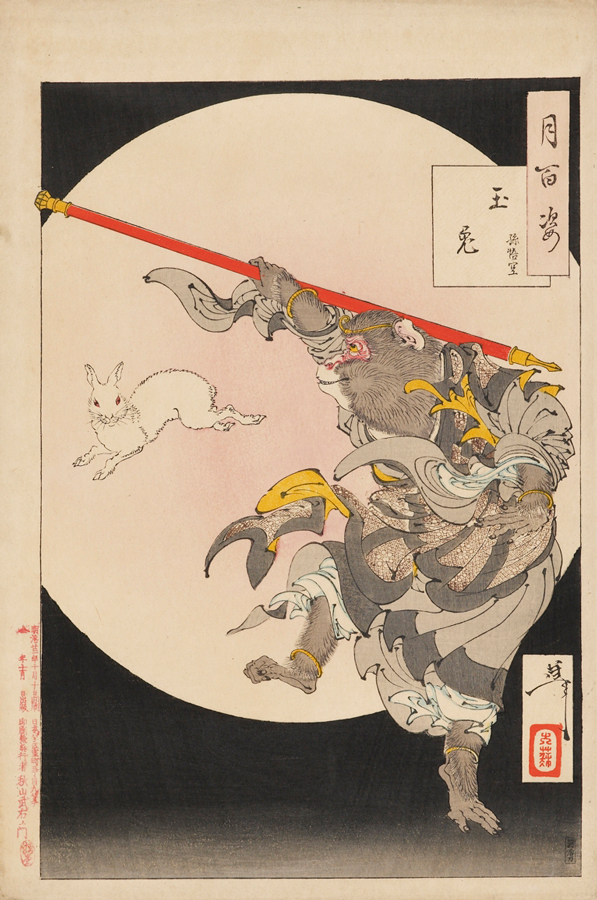Exhibition dates: 14 Jun 2016 to 30 Oct 2016
Gallery 29 | Admission Free
2016 is the Year of the Monkey according to the traditional Chinese lunar calendar. While the lunar calendar and its twelve zodiac animals are distinct to East Asia, images of monkeys feature in the mythology, folklore, art and literature of many cultures around the globe.
This exhibition, drawn from the Ashmolean’s collections of Asian art, celebrates the Year of the Monkey by showing images of monkeys from across Asia. It includes depictions of monkeys in their natural environment and highlights two of the mythical monkey figures best known outside Asia: the Monkey King of Chinese literature and the Hindu monkey warrior Hanuman.
Monkeys in the wild
There are many different species of ape and monkey native to the forests and mountains of Asia, ranging from baboons in the Arabian Peninsula to orangutans in the rainforests of Borneo, long-armed gibbons in China and India, and many varieties of macaque across the whole region. They are widely celebrated in poetry and literature and represented in art.

Ohara Koson (1877–1945), Monkey on a willow branch
Japan, colour woodblock print, 1900, EA1989.177
This print shows a Japanese macaque, a species of monkey that is native to Japan. Ohara Koson was a prolific printmaker, best known for his depictions of birds and flowers. Especially in his early work, Koson’s prints had a very painterly feel. When this print was made around 1900, Japanese prints were made by division of labour; Koson was the print designer who worked with blockcutters and printers under the direction of a publisher.
© Ashmolean Museum, University of Oxford
Monkey King
The Monkey King is the main character in the famous Chinese novel, Journey to the West. First published in the 1500s and attributed to the author Wu Cheng’en, the tale also became enormously popular in Japan. It relates how the Monkey King, after being cast out of heaven, redeems himself by helping the Tang dynasty monk Xuanzang on his pilgrimage to India in search of sacred Buddhist texts. The Monkey King is accompanied by his companions, Pigsy and Sandy and the Dragon Prince, who transforms himself into a white horse for Xuanzang to ride on.

From a set of nine papercuts showing scenes from Journey to the West
China, cut paper, 1980s
The papercut is a distinctive Chinese visual art form, in which artists cut detailed designs in paper using scissors or engraving knives. This set of papercuts depicts characters from the Chinese novel Journey to the West, attributed to Wu Cheng’en (1505–1580). In this tale the Tang Buddhist monk Xuanzang (602–664) and his four disciples, Monkey King, Pigsy, Sandy and the Dragon Prince (disguised as a white horse), head westward in search of scriptures. The Monkey King, also called Sun Wukong, possesses superhuman powers and can travel great distances through the air riding on the clouds.
Presented by John Gittings, ea2008.42.d
© Ashmolean Museum, University of Oxford

Tsukioka Yoshitoshi (1839 – 1892), The monkey Son Gokū with the rabbit in the moon (Songokū gyokuto), From the series ‘One Hundred Aspects of the Moon (Tsuki hyaku sugata)’
Japan, colour woodblock print, 1889
Here the Monkey King is dramatically framed against an enormous moon. In the background is the ‘Jade Rabbit’, which the Japanese see in the moon’s markings, instead of a ‘man in the moon’. As there is no myth that involves these two characters together, it seems to be Yoshitoshi’s idea to bring them together. This series of 100 prints was one of Yoshitoshi’s final works. The subjects, linked only by the presence of the moon in each print, are drawn from various sources in Japanese and Chinese history and literature, Kabuki and Nō theatre.
Presented in memory of Derick Grigs, EA1971.170
© Ashmolean Museum, University of Oxford
Hanuman
One of the most popular Hindu gods is Hanuman the Monkey, in some tales described as a manifestation of Shiva. Revered for his bravery, strength, loyalty and dedication to justice, Hanuman’s heroic exploits are told in the great Hindu epic Ramayana, in which he is depicted as a warrior fighting for King Rama against the evil demon king Ravana. He is also mentioned in several other texts. Some scholars believe that Hanuman mythology might be the origin of the Chinese Monkey King story.

Hanuman sets fire to Lanka with his tail, Ravi Varma Press, Bombay and Lonavla, India
Chromolithograph, Early 1900s
The heroic Hanuman went to spy out Ravana’s fortress of Lanka, secretly visiting Rama’s wife Sita in captivity. He was then caught and Ravana’s son wrapped his tail in an oiled cloth and set it alight. But Hanuman escaped and set the city ablaze as he flew off. The Ravi Varma Press greatly popularised the work of the painter Raja Ravi Varma (1848–1906), who interpreted Hindu mythological scenes in a Europeanised academic style. The eye-catching mass-produced prints deriving from his paintings became widespread in 20th century India, adorning households, shops and tea-houses. Gift of the Church Missionary Society, EA1966.52.113
© Ashmolean Museum, University of Oxford
The Chinese lunar calendar
China and other East and Southeast Asian countries have traditionally used a lunar calendar. This calendar is composed of a repeating twelve-year cycle, with each year corresponding to one of twelve zodiac animals (rat, ox, tiger, rabbit, dragon, snake, horse, sheep, monkey, rooster, dog and pig). Each zodiac animal is believed to represent particular characteristics and people born in a certain year are believed to take on these characteristics. People born in the Year of the Monkey are thought to be lively, intelligent, sociable and at times self-centred.

Monkey King Opera mask, From a set of ten papercuts depicting Beijing opera masks
1980s, dye on cut xuan paper
This papercut shows the Monkey King in the facial make-up of the Beijing opera. The Monkey King is a very popular character in Beijing opera – a type of traditional theatre integrating music, performance, literature and face-painting which rose to prominence in the late 1700s is portrayed as an intelligent, righteous, brave and faithful figure, inaugurating the auspicious tidings of the year of the monkey.
Presented by John Gittings, EA2008.53.j
© Ashmolean Museum, University of Oxford
